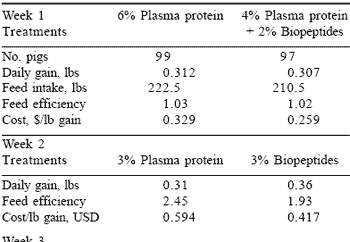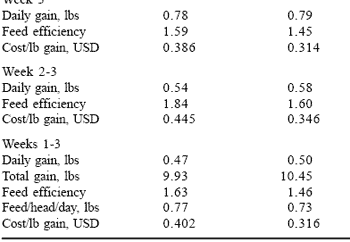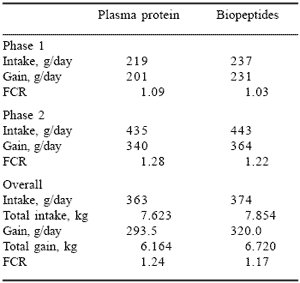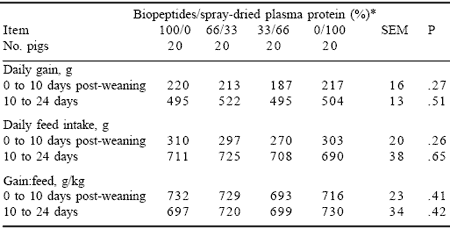Biopeptides in post-weaning diets for pigs: results to date
Where once we considered feed protein to be strictly a means of supplying essential amino acids, we now know that certain peptides produced during gastrointestinal hydrolysis of protein have nutritional and physiological roles.
The potential attributes of biological peptides have been documented in recent reviews (Power and Murphy, 1999) and include sensory, hormonal, antimicrobial, palatability enhancing, anti-carcinogenic, immunoactivity, antioxidant, mineral binding and nutritive functions. A common feature associated with these activities is that only a relatively minute quantity of peptide is required to effect the response.
The livestock industry and their feed suppliers are perhaps as sensitive to nutritional advances as any commercial group. Since rate of gain and efficiency of feed utilization are directly linked to profit, potential improvements in these areas are generally scrutinized for return on investment.
Ration formulation technology has advanced dramatically in the last 25 years with the advent of complex nursery rations, a better understanding of amino acid interactions leading to the development of ideal protein patterns and a host of products including synthetic amino acids, and now peptides, along with an ever increasing list of by-products from other industries.
Besides a direct impact on profitability, external influences such as environmental concerns, animal welfare and human health risks from food contamination also drive the search for new and improved methods of feeding livestock. Nitrogen, typically in the form of protein-rich oilseed meals, is one of the most expensive items to adequately supply in rations.
Excess nitrogen may also be quite putrefactive or volatile in the environment, causing odor and pollution problems. Nitrogen tends to leach rapidly from soils leading to ground water pollution when applied to land either outside the growing season or in quantities beyond what actively growing plants can utilize. Therefore improving nitrogen metabolism in the body holds great appeal to the livestock industry and its suppliers.
Synthetic amino acid availability has provided both nutritional and environmental advantages. Requirements for specific limiting amino acids can be met without adding protein-rich feed ingredients in excess. Judicious use of synthetic amino acids can reduce total ration costs while limiting nitrogen excretion. Although the use of synthetic amino acids is relatively widespread, they unfortunately may be used only at relatively low addition rates.
That free amino acids may not replace intact protein altogether is well understood.
Although research with both ruminants and monogastrics is beginning to unravel the potential of peptides to the animal feed industry (Webb et al., 1992; Webb and Matthews, 1998; Gardner, 1994; 1995), much of the nutritional research with peptides has stemmed from investigations into human applications. Siemensma et al. (1993), investigating peptide applications in human infant formula, outlined several important reasons why peptides have nutritional advantages that differ from amino acids and intact proteins.
These include:
a. Transport of short peptides across the intestinal wall is facilitated by diffusion, in contrast to free amino acids.
b. Peptides are more hypertonic than free amino acids with the net effect of increasing efficiency of absorption and reducing osmotic problems.
c. Short peptides, in many cases, are less antigenic than larger polypeptides or the native protein from which they are derived.
d. Shorter peptides often possess beneficial sensory characteristics.
Webb (2000) summarized other information regarding the nutritional advantages of peptides compared to free amino acids in a presentation to the Virginia State Feed Association:
a. There is a lower energy cost to the body for absorbing peptides. Carrier proteins are involved in moving peptides from the intestine via facilitated diffusion with little or no energy expenditure. On the other hand, individual amino acids are moved via active transport, an energy-requiring action.
b. Peptides are absorbed more rapidly from the gastrointestinal tract as measured by peptide appearance in the blood.
c. Peptides are more stable than free amino acids in the gut as well as within the circulatory system.
Biopeptides, a practical approach
The purpose of this discussion is to present recent results from both field trials and controlled studies, giving an overview of practical responses to a product (Biopeptides) designed to supply dietary nitrogen primarily in peptide form. The focus of the work to date has been on early weaning nutrition.
The peptide supplement used in these studies was produced with microbially derived proteases in a tightly controlled enzymatic process involving several hydrolysis steps. Power and Murphy (1999) have previously discussed the advantages of enzymatic hydrolysis to produce peptides for animal feeding purposes as compared to the use of chemical or DNA recombinant methods.
One important difference between this product and other peptide products in the marketplace for livestock is that the Biopeptide product is based on non-animal protein. Such a product is necessary in the industry owing to prevailing concerns, real or otherwise, about animal proteins in food animal diets. Consumer perception of blood and meat meals has suffered from the BSE and salmonella crises.
In addition, export hurdles and expense for blood-based products preclude use of these high quality proteins in many markets. Others are concerned that use of animal proteins represents a biosecurity risk to otherwise closed herds.
Consequently, several of the following trials examine the potential for replacing spray-dried blood plasma with Biopeptides. The data presented herein will hopefully not only offer alternative solutions, but possibly bring to the forefront a new product capable of improving digestion, absorption and utilization.
Response in commercial studies
TRIAL 1: REPLACEMENT OF ALL OR PART OF THE PLASMA PROTEIN IN DIETS FED WEEKS 1-3
A large Midwestern feed company examined the potential of Biopeptides to replace all or a portion of the plasma protein in the first three weeks of the nursery phase. Biopeptides were substituted for 1/3 of the standard plasma regimen (6%) in week one (Phase 1), resulting in a combination of 4% spray-dried plasma protein/2% Biopeptides. In weeks 2 and 3 (Phase 2), pigs were fed diets with either 3% plasma protein or 3% Biopeptides.
Two hundred hybrid pigs weaned at an average age of 17 days and average weight of 10.45 lb were divided into treatment groups. Although this trial was conducted as a field experiment, it took place in a modern research facility under controlled conditions.
In Phase 1, similar gains and feed conversions were observed, with an advantage shown for the Biopeptides in cost per pound of gain (Table 1; Ferrell, 1999; personal communication). There were numerical improvements for gain, efficiency and cost of gain during weeks 2 and 3. Overall results (weeks 1-3) showed an improvement in daily gain, efficiency and cost of gain for pigs fed the diet containing Biopeptides.
In an interesting side development, pigs at the research facility where the trial was conducted contracted an unidentified virus during the second week of the trial. Pigs fed the Biopeptides showed a dramatic improvement (- 0.52 lb feed/lb gain) in feed conversion efficiency during this week compared to pigs given plasma protein while maintaining higher daily gains, thereby producing a greater difference in cost of gain.
These results are significant because many nutritionists consider plasma protein the additive of choice because of its potential to promote feed intake, especially during a time when intake could be expected to dip below normal due to health problems.
The pigs on the plasma protein diets did consume 0.4 lb more feed per head during this week. However, the pigs fed the diets containing Biopeptides continued to improve growth rate relative to the first week.
Pigs on the plasma protein diet did not show improved growth rate, possibly indicating a much greater utilization of the feed consumed when Biopeptides were included.
Table 1.Commercial performance: effect of substituting 1/3 of the spray-dried plasma protein in Phase 1 and complete replacement in Phase 2 (Trial 1).

Ferrell, 1999.
TRIAL 2: EFFECTS OF 5, 3.75 AND 2.75% PLASMA PROTEIN OR BIOPEPTIDES IN PHASES 1-3
A second midwest feed company evaluated Biopeptides in an on-farm setting utilizing 4000 commercial pigs. Pigs received a three diet sequence containing either plasma or Biopeptides at 5, 3.75 and 2.5%, respectively, in Phases 1- 3 (Table 2, Robbins, 1999; personal communication).
Pigs were placed on test at an average weight of 12 lb and fed until reaching approximately 20 lb on these diets, then were switched to a common diet containing neither plasma nor Biopeptides, and fed to approximately 55 lb of body weight.
Pigs were only weighed at the beginning and end of the nursery phase.
Table 2.Dietary treatments in Trial 2.
Average daily gains were the same for both treatments; however, pigs fed diets with Biopeptides consumed less feed resulting in improved feed efficiency and lower cost of gain (Table 3).
This study was not able to separate treatment effects for the individual phases owing to weighing procedures; however, the final summary demonstrated the potential of biopeptides to provide equal or better performance when compared with plasma under standard commercial conditions for the entire nursery period.
Table 3.Commercial performance: effect of including either plasma protein or Biopeptides on performance of pigs between 12 and 20 lbs (Trial 2).
Robbins, 1999.
Controlled studies in research settings
TRIAL 1. REPLACEMENT OF PLASMA PROTEIN WITH BIOPEPTIDES IN PHASES 1 AND 2
A 21 day evaluation of Biopeptides in nursery pigs was conducted at the University of Manitoba. The trial utilized 144 Cotswold pigs weaned at an average age of 16 days with average weight of 5.5 kg (12.1 lb).
Dietary treatments included either 6% spray-dried plasma protein or 6% Biopeptides in Phase 1 (days 16-23) with the test ingredients reduced to 3% during Phase 2 (days 23-27).
Pigs fed diets containing Biopeptides consumed more feed, had higher rates of gain and lower feed conversion ratios in both phases of the trial (Table 4, Baidoo, 1999; personal communication). Pigs fed Biopeptides were 0.55 kg (1.2 lb) heavier after at the end of the three week period.
Table 4. Effects of plasma protein and Biopeptides on pig performance during Phases 1 and 2.
Baidoo, 1999
TRIAL 2. GRADED LEVELS OF BIOPEPTIDES AND PLASMA PROTEIN IN DIETS FED WEEKS 1-3 POST-WEANING
A trial conducted at the Ohio State University by Don Mahan investigated whether some combination of spray-dried plasma protein and Biopeptides would give better performance than either would individually. Eighty crossbred pigs weaned at an average age of 21 days (average weight of 12.9 lb) were used to evaluate several combinations of plasma protein and Biopeptides.
Pigs were divided into four treatment groups for a 10 day Phase 1 period followed by a 14 day Phase 2 period. Treatments consisted of a positive control containing 6% plasma protein, 4% plasma protein plus 2% Biopeptides, 2% plasma protein plus 4% Biopeptides, and 6% Biopeptides.
The basal diet contained 41.5 and 13.5% corn and soybean meal (48%) during Phase 1 and 42.5 and 21.0% corn and soybean meal in Phase 2.
Dried whey and lactose were included at 20 and 10%, respectively, in Phase 1 and 15 and 10% during Phase 2. Phase 1 diets were formulated to contain 1.6% lysine. Phase 2 diets contained 1.45% lysine.
No significant differences were noted for daily gain, feed intake or feed efficiency between the protein sources during the initial two phases of the post-weaning period (Table 5). Weaned pigs apparently utilized the protein sources equally well.
In Phase 3 pigs were fed a common diet containing neither of the test protein sources for 14 days. No differences were noted for gain, intake or feed efficiency during this phase.
Table 5.Effect of protein source on pig performance.
*80 pigs in 5 replicates weaned at 21 days with 5.83 kg average initial weight. Mahan, 1999.
TRIAL 3. GRADED LEVELS OF BIOPEPTIDES AND PLASMA PROTEIN IN DIETS FED WEEKS 1-3 POST-WEANING
An experiment with the same dietary treatments as the Ohio State study was conducted at Michigan State University by Trottier and co-workers.
Ninety-six crossbred pigs were allotted in five replicates per treatment. Pigs in this trial were weaned between 14 and 24 days at an average initial weight of 6.12 kg (13.5 lb). No differences in performance were found at the end of the first two phases or for the three phases combined (Table 6).
Average daily gains and gain to feed ratios were similar among all treatments.
Table 6. Effect of protein source on pig performance, overall summary.
*96 pigs in 5 replicates weaned between 14 and 24 days with 6.12 average start wt. Trottier et al., 1999.
TRIAL 4. EFFECT OF BIOPEPTIDES IN BASAL DIETS WITHOUT PLASMA PROTEIN
A trial was conducted at Harper Adams University College in the UK to evaluate the effectiveness of Biopeptides in a basal diets that did not include plasma protein (Stewart, 1999).
A total of 320 Cotswold pigs with an average age of 28 days and an average weight of 8.9 kg (19.6 lb) were used for this trial. Prior to weaning, all pigs had free access to a common creep diet.
During Phase 1 (days 29-35) pigs received diets containing either 0 or 5% Biopeptides. The Phase 2 diet contained either 0 or 2.5% Biopeptides. Diets contained equal amounts of amino acids and energy. In this study, Biopeptides replaced portions of the fish meal and full fat soy protein.
Although differences were not statistically significant, numerical trends were evident (Table 7). In Phase 1, feed intake was increased by 25 g/day with the inclusion of Biopeptides; however, gain was 8 g/day less, resulting in a difference in feed conversion ratio. Feed intakes remained higher in phase 2, with gains also increasing for pigs fed diets containing Biopeptides.
In the overall summary, pigs had higher intakes, increased gain and improved feed conversion ratios with the inclusion of Biopeptides.
Table 7.Effects of Biopeptides on pig performance during Phases 1 and 2.
Stewart, 1999.
Summary
Following a year of testing the Biopeptides in commercial and research conditions, the data indicate that this product can not only replace some important traditional protein sources, including those of animal origin, but may in many cases be superior to these proteins for young pigs.
Even in complex diets where nutritionists typically try to use a variety of animalbased proteins, the Biopeptides appear to be performing as well as or better than the animal-based counterparts.
Biopeptides did not appear to enhance feed intake to the degree noted for plasma protein; however in the absence of plasma or using restricted amounts of plasma, Biopeptides may serve to boost intake.
Since vegetable-based proteins do not have the same amino acid profile as animal products, it appears that supplying nitrogen to animal species in a peptide form offers exciting potential.
Additional research is needed to better delineate the physiological mechanisms by which peptides enhance performance.
The possibility that peptides may offer an even greater performance response during periods of health challenge also merits further investigation.
In situations where certain animal proteins are deemed unsuitable for inclusion, this product would certainly seem to hold even greater promise for improving performance.
References
Author: G. WALTER TIBBETTSBaidoo, S.K. 1999. Evaluation of UP 1672 for early weaned pigs. Research report to Alltech. University of Manitoba, Canada.
Gardner, M.L.G. 1994. In: The Physiology of the Gastrointestinal Tract. (L.R. Johnson, ed.). Raven Press, New York, pp. 1795-1820.
Gardner, M.L.G. 1995. In: Absorption of Orally Administered Enzymes. (M.L.G. Gardner and K.J. Steffens, eds.). Springer-Verlag, Berlin, pp. 1- 7.
Mahan, D.C. 1999. Comparison of plasma protein and ultimate protein in the diets of starter pigs. Report to Alltech. Ohio State University.
Power, R. and R. Murphy. 1999. Biologically active peptides: sources, production and nutritional importance. In: Biotechnology in the Feed Industry, Proceedings of Alltech’s 15th Annual Symposium (T.P. Lyons and K.A. Jacques, eds.). Nottingham University Press, Nottingham, pp. 435- 447.
Siemensma, A.D., W.J. Weijer and H.J. Bak. 1993. The importance of peptide lengths in hypoallergenic infant formulae. Trends Food Sci. Technol. 4:16-21.
Stewart, A. 1999. Biological peptides for weanling pigs. Research report to Alltech. Harper Adams University College, UK.
Trottier, N., E. Otto and J. Perez-Laspiur. 1999. Tri State Weanling Pig Project. Replacement of starter protein source. Unpublished. Michigan State University.
Webb, K.E. 2000. Peptide absorption. Presented at theVirginia State Feed Association Meeting. Feb.16-17. Hot Springs, VA.
Webb, K.E. and J.C. Matthews. 1998. Peptide absorption and its significance in ruminant protein metabolism. In: Peptides in Mammalian Protein Metabolism. (G.K. Grimble and F.R.C. Backwell, eds.). Portland Press, London, pp. 1-10.
Webb, K.E., J.C. Matthews and D.B. DiRenzo. 1992. Peptide absorption: A review of current concepts and future perspectives. J. Anim. Sci. 70:3248-3257.
Alltech Inc., Nicholasville, Kentucky, USA





.jpg&w=3840&q=75)